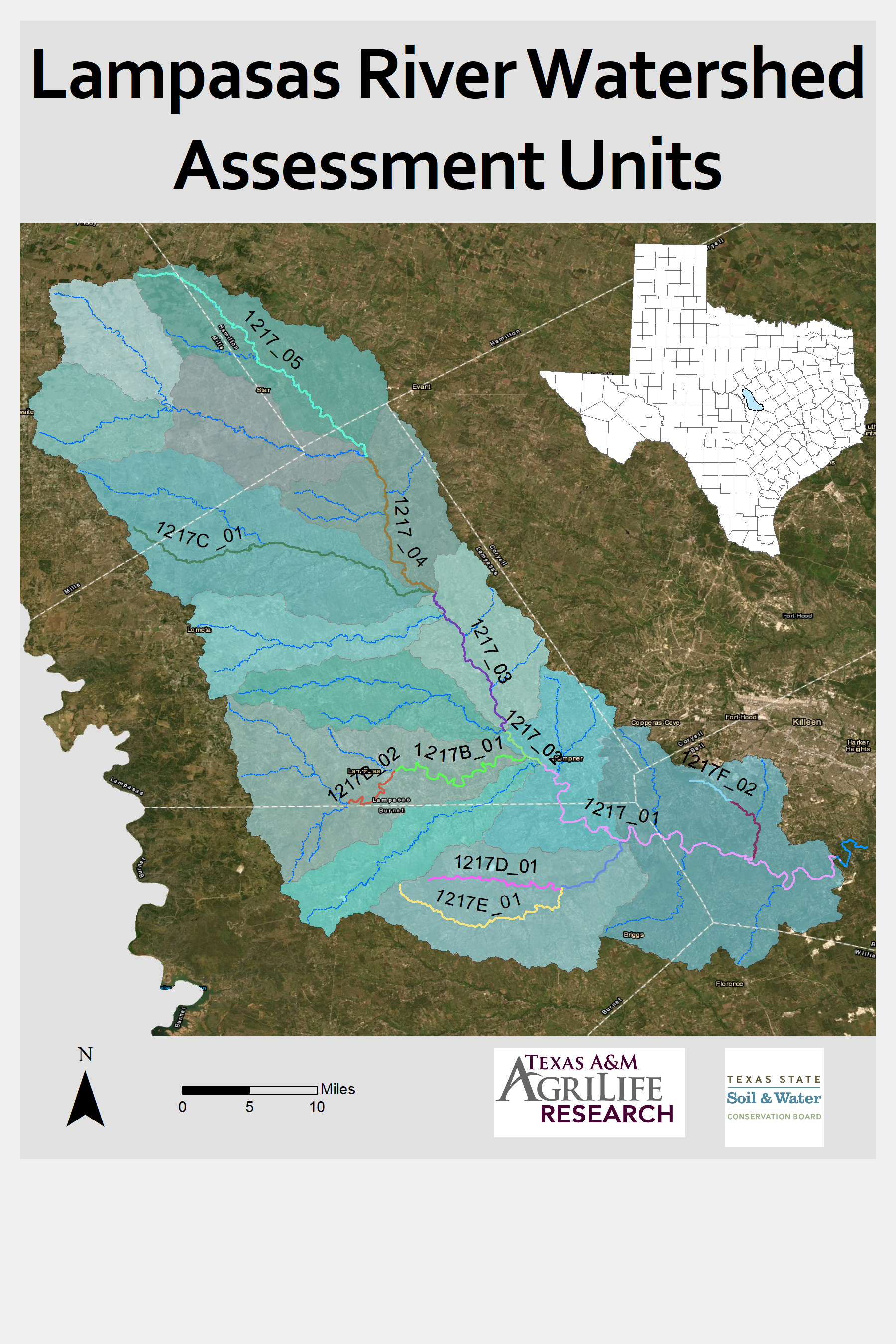Overview
The Lampasas River (segment 1217) rises in eastern Mills County, 16 miles west of Hamilton and flows southeast for 75 miles. The river courses through Hamilton, Lampasas, Burnet and Bell Counties. In Bell County the river turns northeast and is dammed five miles southwest of Belton to form Stillhouse Hollow Lake (Segment 1216). Below Stillhouse Hollow Lake, the Lampasas River flows to its confluence with Salado Creek and the Leon River to form the Little River.
According to the 2002 through 2008 Texas Water Quality Inventory and 303(d) List, the Lampasas River was impaired by elevated bacteria concentrations and did not meet Texas Surface Water Quality Standards for contact recreation. AgriLife Research and TSSWCB established the Lampasas River Watershed Partnership in November 2009 as part of TSSWCB project 07-11, Lampasas River Watershed Assessment and Protection Project. This project updated land use, modeled water quality, and developed a WPP to address the bacteria impairment. With technical assistance from AgriLife Research and other state and federal partners, the Steering Committee identified water quality issues that are of importance to the surrounding communities. The WPP identified responsible parties, implementation milestones, and estimated financial costs for individual management measures and outreach and education activities. The WPP was accepted by EPA and the Steering Committee 2013. Although the river was removed from the 2010 Integrated Report due to a lack in historical data, it has been relisted on the 2022 Integrated Report for not meeting the state standards for contact recreation.
The Steering Committee recommended establishing a permanent watershed coordinator in the WPP to facilitate implementation of the Lampasas River WPP. The WPP states, “In addition to technical and financial assistance required for implementation of management measures and outreach programs, it is recommended that a full-time Watershed Coordinator be employed to facilitate continued progress, throughout the 10-year implementation schedule. This position will oversee project activities, seek additional funding, organize and coordinate regular updates for the LRWP, maintain the website, and coordinate outreach and education efforts in the watershed.” Although the WPP outlined a 10-year implementation schedule, the river’s new status on the Integrated Report illustrates the need for continued efforts within the watershed.
Since acceptance of the WPP, several projects have been used to coordinate and implement the outreach and education strategy of the Lampasas WPP. TSSWCB 12-09, Coordinating Implementation of the Lampasas River WPP, TSSWCB 14-07, Continued Coordinating Implementation of the Lampasas River WPP, TSSWCB 17-05 Continued Coordination and Implementation of the Lampasas River WPP, and TSSWCB 20-10 Coordination and Implementation of the Lampasas River WPP have all been used to continued facilitation of the Lampasas River WPP through September 2023 by funding a full-time Watershed Coordinator as outlined in the WPP.

Multiple projects in the watershed have been utilized to implement other components found in the WPP. The Watershed Coordinator prepared proposals and provided subsequent project support and guidance to Hill Country Soil and Water Conservation District to address NPS contributions from agricultural lands through technical and financial assistance for landowners and producers within the watershed. This assistance was provided most recently through TSSWCB 20-07 Implementation of Agricultural NPS Components of the Lampasas River WPP.
Additionally, NPS contributions from failing on-site sewer systems is being addressed through the development of a watershed-wide geodatabase and inventory of OSSFs (TCEQ 17-70432, Lampasas River Watershed Protection Plan Implementation – On-site Sewage Facilities Database). TCEQ 20-10176, Lampasas River Watershed Protection Plan Implementation – On-site Sewage Facilities Remediation replaced 20 failing OSSFs within the watershed, with an estimated bacteria load reduction of 3.965E+13 cfu/100 mL. Funding for an additional 20 systems was secured and Phase II began in February 2023.